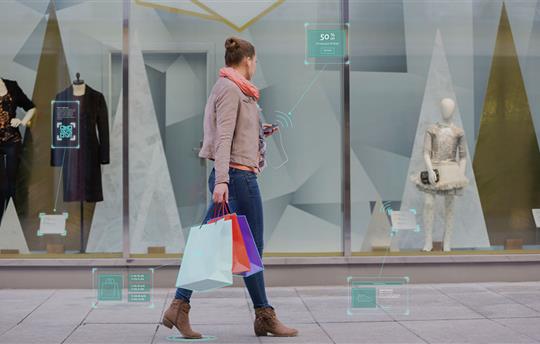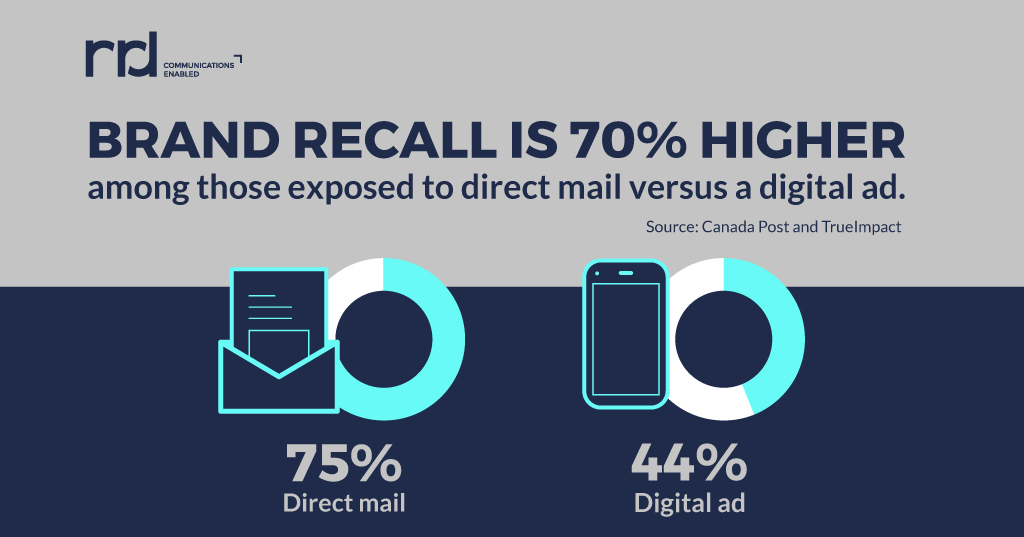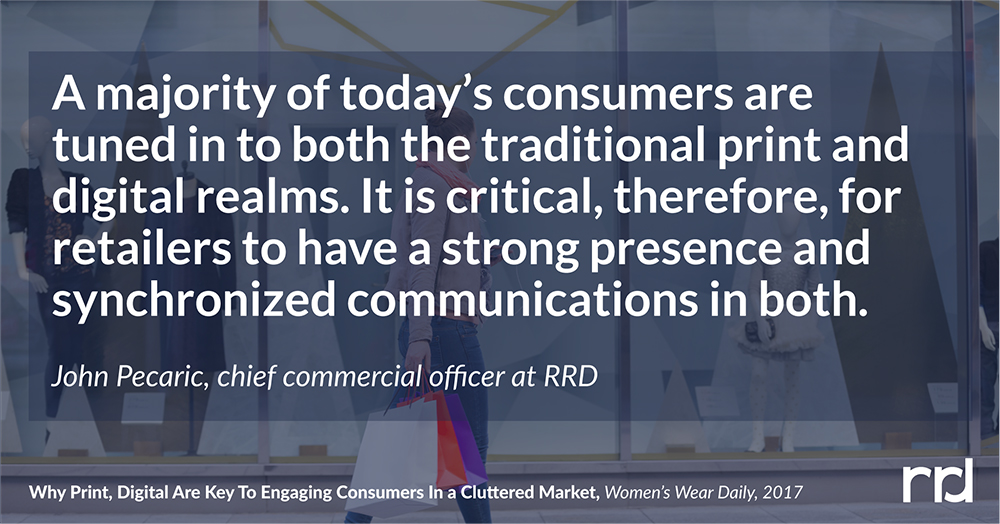Why Print, Digital Are Key To Engaging Consumers In a Cluttered Market: Q&A with RRD’s John Pecaric
10/18/2017 Ellie Behling

Many companies in the retail space are under pressure as the market undergoes a transformation driven by changes in consumer behavior and preferences. While traditional bricks-and-mortar stores shutter doors, e-tailers — including online giant Amazon Inc. — are opening and acquiring more. The changes are fast and furious, and are also implicating how retailers and fashion brands market to and engage with consumers. And just like the convergence of online and physical retail, companies are learning there’s a convergence occurring between print 1 and digital. Here, John Pecaric, chief commercial officer at R.R. Donnelley & Sons Co., which is a multichannel marketing solution provider with clients that include Wal-Mart Stores Inc., Kohl’s Corp. and Ulta Beauty, shares his insights on this trend and how companies need to respond.
The text of this article originally appeared in the June 23, 2017, issue of WWD.
WWD: How would you describe today’s communications environment?

John Pecaric: Retail is one of RRD’s long-standing and largest market segments, with 92 of the top 100 retailers partnering with us to drive consumer engagement, sales and ROI. We’ve witnessed significant transformation in the retail market over the years, but none more exciting — and challenging — as the one we’re seeing today.
Today’s communications environment is multifaceted and complex, and it’s evolving continuously. From the mailbox to the in-store experience to mobile and social media, our retail customers face the challenge of more effectively navigating these channels in ways that attract customers, boost market share and result in long-term brand loyalty.
The digital age requires every business to not just communicate with customers and prospects, but connect and engage with them on deeper, more personal levels. While some brands are doing this well, many others are working hard to catch up and effectively pivot and/or evolve their approaches to suit today’s consumers.
Additionally, our experience in this market tells us that there is no one-size-fits-all approach when it comes to reaching and engaging with consumers. Different channels are viable at different times and are dependent on many external factors such as timing, content, mood, circumstance and more. Marketers recognize that while today’s consumers are web-savvy, mobile-enabled data sifters, they do not pounce on whichever brand or store offers them the best deal — nor have they tossed brand loyalty aside.
WWD: So, what are the implications? What do retailers and brands need to do?
J.P.: Today, more than ever, brands need to identify creative, yet meaningful ways to reach and engage their target audiences through different channels. In order to be successful, they must take advantage of the unique properties offered by both digital and print. While digital offers convenience and accessibility, studies have shown that print can be more impactful in solidifying brand recognition and customer loyalty. Specifically, a study by Canada Post and neuromarketing firm TrueImpact showed 70% higher brand recall for direct mail versus digital ads. Even notoriously digital Millennials are opening direct mail at the same rate as the rest of the population, 66%, according to a separate study by Experian.

At RRD, we are uniquely qualified to assist in the development of cohesive multichannel programs for retailers. What sets us apart is our understanding and experience in producing effective marketing materials both in print and in digital.
We help brands refine their strategies on both a macro and micro level, to ensure that their marketing is targeted, measurable and cost-effective. As a leading provider of communications services, we are providing multichannel, end-to-end solutions to our clients in order to help bridge both worlds.
WWD: Why are consumers bombarded with so many marketing messages?
J.P.: There’s no doubt that consumers are seeing/hearing more marketing messages than ever before.
Fifty years ago, consumers were mostly marketed to at home, when they were watching TV, reading newspapers/magazines or checking their mailboxes. However, with today’s consumers fully embracing mobile and digital platforms, retailers can now reach customers on-the-go and engage with them on more personal levels via email, in apps or on social media.
What consumers are seeing now is a mix of marketers doing what has traditionally worked — direct mail, email, television commercials in some cases — combined with newer, more cutting-edge approaches to reach consumers where they’re spending the most time: online and on their mobile devices.
The trick for retailers now becomes how to determine which messages, channels, activities, volume, content and cadence best engage rather than disengage consumers — and ultimately drive the campaign’s success.
Take email for example. While email is still considered to have the highest ROI of any marketing tactic, it’s becoming increasingly difficult to stand out in the crowd when so many others are executing similar programs. Today, one company’s innovative email marketing campaign easily becomes one of hundreds that lands in consumers’ inboxes every day. That is one of the reasons why direct mail remains a critical component of multichannel marketing campaigns.
WWD: How should brands engage consumers in today’s retail environment? What does it require?
J.P.: Consumers have more choices than ever before — they can choose where they physically want to shop, how much they want to pay, how quickly they want to get their purchase, or even how they want their purchase to be made. Greater choice has chipped away at brand loyalty and that’s creating a real challenge for retailers.
In fact, a recent study by Accenture found that “46% of U.S. consumers said they’re more likely to switch providers than they were 10 years ago.” For brands wanting to engage the modern consumer and maintain their interest, they must find ways to stand out against the noise and brand saturation taking place today in apps, on mobile and in email and engage consumers in more meaningful ways. In order to do this, retail brands have to do two things.
First, they need to better synchronize communications across an increasingly complex maze of channels, both on and offline, in order to get in front of modern consumers to earn or maintain their loyalty. This requires retailers to develop campaigns that not only cater to their unique audience(s), but also understand where and how to reach them no matter the device, message, size or screen.
Second, retailers need to embrace sophisticated measurement and data analysis approaches to determine the effectiveness of their marketing campaigns. Consumer behavior is evolving just as fast as many of the channels they’re consuming information on. What worked last year may not work today. RRD firmly believes that data insights are the best way to understand what’s truly resonating and connecting with today’s consumer. Many of the world’s largest retailers are working with us to help them understand the real impact they’re having in the market.
WWD: Is this also true for communications? Is there a need for print and digital? Why?
J.P.: This is absolutely true for communications. There are very few individuals who are committed to one source of information. Rather, a majority of today’s consumers are tuned in to both the traditional print and digital realms. It is critical, therefore, for retailers to have a strong presence and synchronized communications in both print and digital.

For example, many of our retailer customers are layering in direct-mail campaigns with other digital and/or mobile-focused marketing tactics to reach and engage Millennials. Unlike other generations, this age group typically has not received a large volume of mail at home and with less competition in the mailbox, direct-mail pieces now become an effective way for brands to stand out. We’re seeing this approach quite a bit among e-commerce brands in particular, with some strong results.
Recently, one online retailer in the family apparel/accessories and home decor space increased the ROI of a marketing campaign by 24% as a result of integrating RRD’s direct-mail solutions with its existing online marketing programs.
By segmenting and targeting its customers with information gained through data analytics, we were able to help the retailer strengthen the bond between its brand and consumers, resulting in more online purchases.
The key to all of this — print versus digital, mobile versus social, radio versus TV — is for retailers to understand who their customers are, where they’re spending time and consuming information and what compels them to take action. Create and execute campaigns from this insight and retailers will be well-positioned to move the needle for their brands.
How can we help create an effective multichannel communications strategy for your brand? Contact us.
Want even more multichannel marketing insights? Check out our quarterly magazine, RRD Connect.
This post was originally published October 18, 2017.